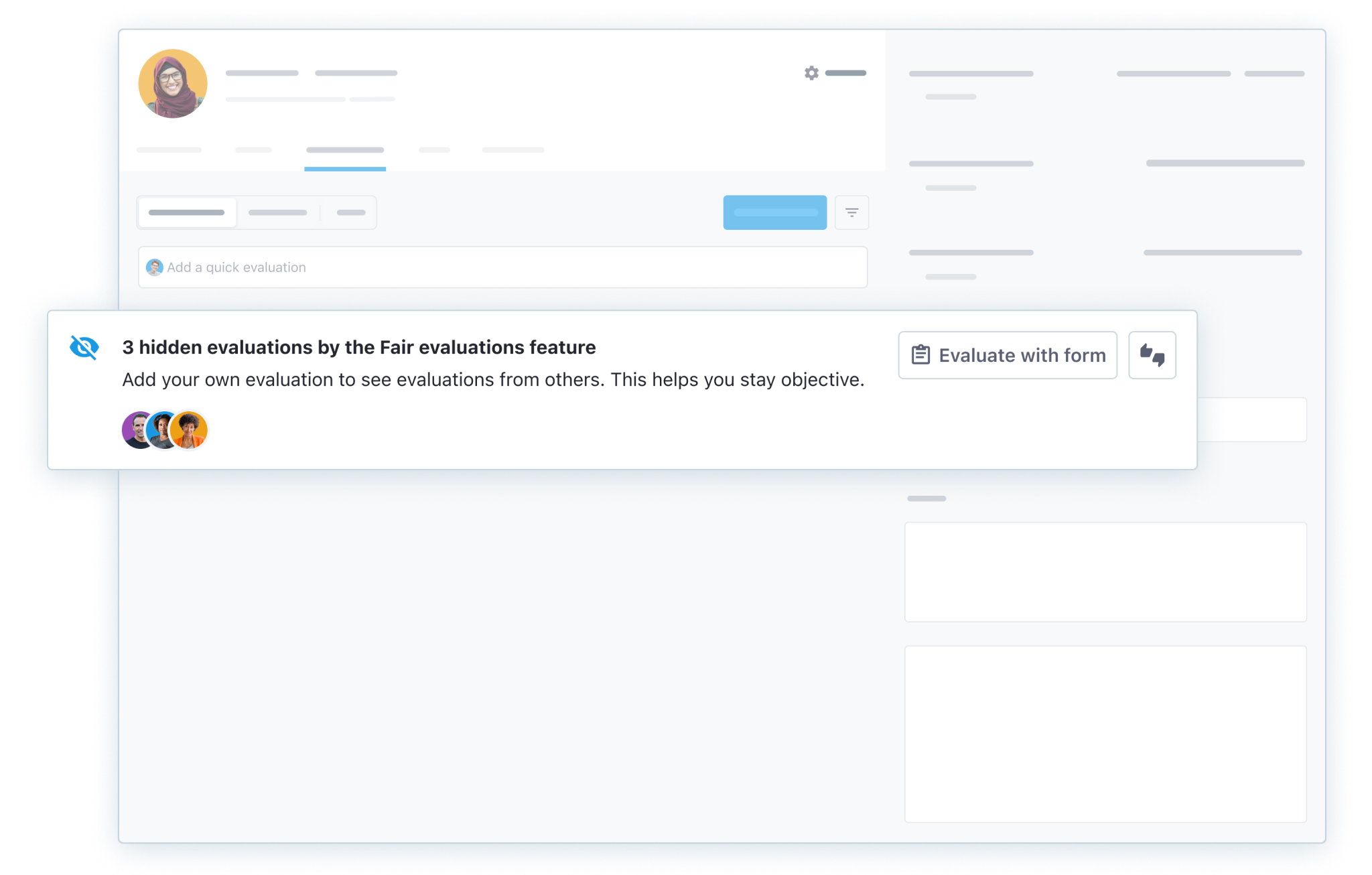Strategic, structured, and transparent candidate evaluation helps to guarantee both a fair hiring process for candidates, and more successful selection decisions for organizations.
Candidate evaluation takes many forms—from culture fit assessment to skills competencies. The specific criteria companies prioritize will vary depending on the role and organization, but all recruiters need a well-defined evaluation criteria to ensure they’re doing their due diligence with each and every hire.
When candidates are evaluated properly, they’re more likely to be a good fit for the role and company. This means they'll be more productive, engaged, and profitable for the organization in the long run.
This article will help you understand the importance and role of candidate evaluation, and give you tips, techniques, and tools to help you improve your process.
What is candidate evaluation?
Candidate evaluation is the process of assessing a candidate's skills, qualifications, and experience to determine their suitability for an open role. There are multiple candidate assessment methods, including interviews, work sample tests, and reference checks.
The process often involves multiple steps, such as:
- Completing application forms
- Scoring qualifications
- Skills assessments
- Behavioral assessment
- Personality tests
- Social profile reviews
- Reference checks
This list isn’t comprehensive but includes some of the most common candidate evaluation techniques that a company may use. Many organizations also develop their own unique evaluation steps that help them screen for very specific personality traits or skill sets.
No matter the evaluation approach you prefer, it should be fair to ensure all applicants get an equal opportunity.
5 benefits of candidate evaluation for organizations
Candidate evaluation offers many benefits for organizations, including the ability to identify the best candidates based on skills, competency, and cultural fit.
Here are six key candidate evaluation benefits to consider:
1. Reduced bias in the hiring process
The first benefit relates to the very real issue of bias in hiring. Candidate evaluation alone won’t solve issues with bias, but implementing the right types of evaluations, scoring criteria, and bias training will go a long way to reducing it.
For example, organizations can implement structured interviews and scorecards to ensure that all candidates are evaluated using the same questioning and scoring criteria for all interviews. This leads to fairer and more objective evaluations and, by extension, hiring processes, ensuring that the objectively best candidate is selected rather than one whose personality may align with the recruiters.
2. Better team fit and alignment
Candidate evaluations assess both skills and cultural fit, ensuring that organizations gain a well-rounded picture of each candidate. This helps organizations understand each candidate as deeply as possible, and are able to weigh various factors to determine the ideal hire.
Including team alignment and cultural fit in this process helps to ensure that the candidate not only has the skills to do the job, but also that they’re likely to feel aligned and connected with their colleagues. This helps to foster strong and healthy teams that will ultimately perform better for the company.
3. Better decision-making
A structured candidate evaluation process means that evaluators have a complete and well-rounded understanding of each applicant. When they do, it makes the decision-making process much smoother by showing objective reasoning behind one candidate may be better than another.
This allows for not only more reliable decision-making, but also a more efficient one that reduces time to hire and allows companies to identify and secure top talent quickly.
4. Improved candidate experience
Well-structured evaluation processes don’t just benefit the organization, but candidates as well. When candidates are evaluated through a well-organized and transparent process, they feel respected and valued, even if they are not ultimately selected.
This positive experience reflects well on the company’s brand, encouraging future applications and word-of-mouth referrals, which are essential in today’s competitive job market.
5. More effective skills-based hiring
Candidate evaluation processes that specifically prioritize skills-based hiring help organizations identify candidates with the right abilities to perform the job effectively, regardless of their educational background or previous job titles.
This is a game-changer for organizations competing for increasingly scarce skill sets, such as AI engineers, as it allows them to identify candidates who may not fit the traditional mold.
This is a major priority for many organizations today. According to LinkedIn’s The Future of Recruiting Report for 2024, 73% of surveyed recruiting professionals said that skills-based hiring was a top priority going forward.
6. Improved hiring quality
Ultimately, a well-formed candidate evaluation process helps organizations make informed and objective hiring decisions against defined criteria. They remove the guesswork, and help organizations seize the best possible talent that’s available to them.
This structured approach ensures that hires are not only qualified but also align with company culture and team dynamics, leading to higher job performance and better retention rates.
Candidate evaluation criteria: what should you assess?
There are five key candidate evaluation criteria to focus on when screening applicants for a new position. Let’s explore each one.
Experience
Experience is critical in determining a candidate's suitability for a role. Having a track record that validates their skills shows they can handle the job more competently. Experienced candidates can also lower your onboarding costs as they require less training than inexperienced ones. In addition, they acclimatize to the company much quicker, which can reduce the loss of productivity.
Potential
In addition to experience, candidate potential is the next factor you should look for in a good hire. They might have yet to demonstrate a track record in the role you're hiring for, but they have abilities that depict them as potentially high performers. For instance, a candidate who graduated at the top of their class, has held leadership positions throughout their schooling, or participated in activities demonstrating their zeal and commitment to tasks can show their potential in performing in your role.
This type of mindset is needed if organizations are taking a skills-based approach to hiring. Candidates can have no formal training or experience in a specific role, but be able to demonstrate a high level of technical competence in their area of focus. By assessing based on skill, and evaluating based on potential, organizations can find diamonds in the rough that other organizations may be overlooking.
Hard skills
Hard skills refer to the practical knowledge a candidate has acquired through training either in school or past jobs. Having hard skills is necessary to demonstrate a candidate's ability to perform the job. Some jobs require specialized training, while others are more flexible on the training an applicant must possess.
Soft skills
Soft skills are hard to measure but equally important to succeed in the role. Every position requires a unique combination of soft skills based on the job demands. For instance, one needs good leadership or problem-solving skills to succeed in a managerial role. On the other hand, a role in marketing or human resources demands excellent communication skills and so forth.
Cultural fit
Culture changes from one organization to another. Even teams within an organization can have different cultures. The candidate should be able to fit into the company or team culture to thrive in their role. For instance, some positions require team collaboration, while others favor working individually.
Defining your culture allows you to attract and identify talent highly likely to align with your work mode. An employee who fits into your culture well will be happier, which boosts employee engagement and retention.
How to evaluate candidates
Having seen the benefits of candidate evaluation and factors to prioritize when hiring, let's discuss how you should go about the process.
Mainly, the process can be broken down into three steps – before, during, and after the interview.
1. Before the interview
The candidate evaluation process starts well before the first round of interviews. Rather, it begins with establishing both the ideal candidate persona for the open role, and the criteria you’ll use to assess applicants against those persona requirements.
Here are the key steps to take before the interview process begins.
Create a candidate profile
First, the recruiter and hiring manager will meet to define who the ideal candidate for the open position is. This will include outlined required skills, qualifications, and experience, in addition to other attributes that the candidate will need to be successful.
This candidate profile forms the basis against which applicants are assessed.
Align with the hiring team
Once that profile has been created, the recruiter and hiring manager should meet with the recruitment team to brief them on what type of applicant they’re looking for and where they will source them from.
This ensures the hiring team is aligned around a common goal, and understands what to look for during their evaluation tasks.
Tip:
Tip:
With Reruitee by Tellent, recruiters can add hiring team members to a job opening and assign them roles and responsibilities. The team can communicate through the Recruitee platform, drop comments on candidate profiles, and stay aligned on which candidates progress through the hiring process.
Establish evaluation standards
Next, the hiring team needs to develop clear and objective evaluation criteria for each candidate. This can include minimum experience and education, criteria for assessing skills competencies, and scorecards to help measure interview answers.
This is a good time to create a standardized list of questions to ask during structured interviews, along with the scorecards used to evaluate each candidate.
Construct an application form
The application form is the stage in the candidate evaluation process, and should be tailored to help recruiters weed out candidates who don’t meet minimum requirements early.
Design an application form that gathers relevant information, such as work history, skills, and motivational questions. Include questions that help determine if a candidate meets specific minimum requirements. If they don't, your applicant tracking software (ATS) can be used to automatically remove these applicants from consideration.
Tip:
Tip:
Recruitee by Tellent allows you to create custom application forms by role, with option to add specific screening questions based on the candidate persona and job requirements. Knock out questions can also be added to these forms, allowing you to immediately disqualify candidates who don’t meet basic or minimum requirements.
Plan for skills assessments and tests
In tandem with the above, hiring teams should also be behind designing job tests or assessments that can be used to measure each candidates’ competencies in required technical or cognitive skills.
These assessments can take place multiple times throughout the evaluation process, including post-application and after the first round of interviews. Plan how these assessments will be integrated into the evaluation process and ensure they are fair and relevant to the role.
Recruitee has integrations with online skills assessments tools that users can use as part of their evaluation.
Pre-screen candidates
Conduct an initial phone or video screening with candidates who made it through the application phase and, therefore, meet basic qualifications.
Use this stage to confirm details from the application and gauge overall interest in the role to determine if candidates should move through to the interview stage.
Shortlist candidates
Based on the assessments above, narrow down the candidate list to those who are qualified to move to the interview stage.
2. During the interview
The interview phase is the most important part of candidate evaluation. This is where the hiring team learns about the candidate from their own mouth, helps to form an understanding of who they are, what they have done and can do, and what motivates them professionally.
Here’s how to ensure a successful candidate evaluation during the interview phase.
Ask structured interview questions
Interviews are one of the recruitment stages that are most susceptible to bias. Interviewers, as humans, naturally gravitate towards individuals who are like them. This, of course, can cause hiring teams to overlook qualified candidates who don’t share the same personality traits and background as the hiring team, resulting in an unfair evaluation process and missed opportunities for both parties.
Structured interviews help to alleviate this bias by ensuring that all candidates are asked the same set of primary and follow-up questions, ensuring that they’re graded on an equal playing field.
When planning a structured interview, make sure to account for the various types of questions you’d like to ask, including:
- Skills-based questions
- Situational questions
- Behavioral questions
- Culture fit questions
By doing so, the hiring team not only creates a well-rounded view of the candidate, but also ensures that each candidate is treated equally.
Observe and take notes
Interviewers should take extensive notes during each interview to help them remember key moments and insights from their conversations. This isn’t necessarily an exercise in recording everything the candidate says, but rather jotting down personal observations related to specific answers.
For example, interviews will likely be looking for specific signals or clues that will help them understand the candidate’s personality and how they think. Making notes about how a candidate answers specific questions, or how they interact with a panel of interviewers can help capture and record insights that might not be captured in a structured interview scorecard.
These notes can be used as an extra layer of information that the hiring team uses when discussing and evaluating each candidate.
3. After the interview
After the interview rounds are complete, the last step is to evaluate the results and come to a consensus on the ideal candidate. This can include the following steps.
Complete the interview scorecard
First, complete the structured interview scorecard, record notes in your collaborative hiring platform, and share unique insights about each candidate. Each team member involved in the interview process should do this for each candidate.
Make sure that each hiring team member records their personal insights individually, before conversations about candidates start. This will ensure that everyone is able to formulate and share their own perspectives, without being influenced by others on the team.
Be aware, though, that sharing collaborative feedback can actually introduce bias unless proper controls are put in place. For example, if a more junior hiring team member interviews a candidate and goes to add feedback about that person, only to find that their supervisor has already left their own detailed notes, they may be more inclined to alter their input so that it’s inline with the more senior team member.
To avoid this, Recruitee by Tellent offers a feature called Fair Evaluations, which hides feedback from hiring team members until after the individual in question has added their own input.

Assess the results collaboratively
Next, come together as a team to share insights and observations about each candidate. This is where collaborative hiring really pays off and helps to form a deeply informed and objective assessment of each candidate.
This collaboration should be done live, but it can be facilitated using async tools that allow hiring team members to drop comments onto each candidates’ profile to help foster a more in-depth conversation.
Conduct additional testing, if needed
Interviewing has featured heavily in this article so far, but assessments and testing also play a significant role. Throughout the interview process, it might also be necessary to conduct assessments that help teams to objectively determine skills competencies related to the role.
This may be conducted after the interview round, or a key milestone during this process.
Make a hiring decision
Once all perspectives have been shared and analyzed, the last step in the process is to select the most suitable candidate and extend a job offer.
Tips for a successful candidate evaluation process
Creating a clear mandate and set of practices will help ensure your candidate evaluation process is impactful and sustainable. Again, setting yourself up for success comes down to the right planning and a dedication to your established processes.
Here are some ways you to ensure fair and transparent candidate evaluations for the long haul:
- Set the right expectations from the start.
- Source in the right places.
- Share and adhere to hiring timelines.
- Brief candidates on the process.
- Train your employees on fair interviewing techniques.
- Create a culture of open feedback.
- Use automation tools to ensure objective shortlisting.
Candidate evaluation processes come in many different shapes and sizes, depending on the company and the position in question. Techniques and philosophies will inevitably vary depending on the organization.
What is consistent, however, is that job seekers want to feel like they’ve been treated fairly. Delivering on that will help your company establish itself as a fair and desirable employer, which will undoubtedly result in more and better talent knocking on your door.









